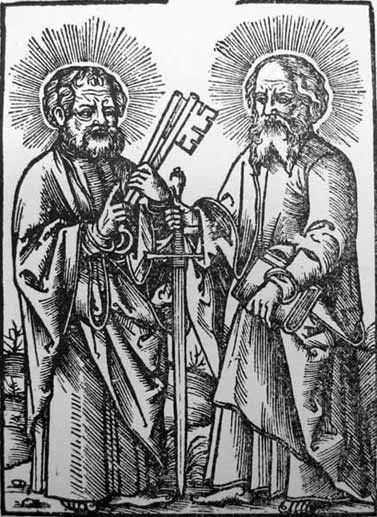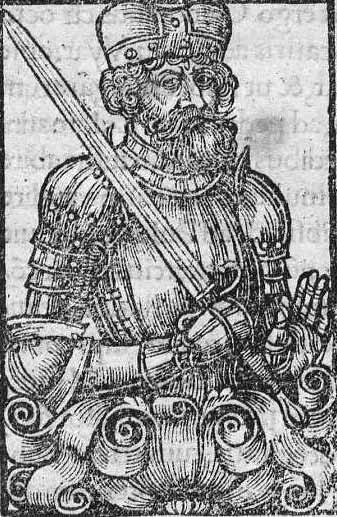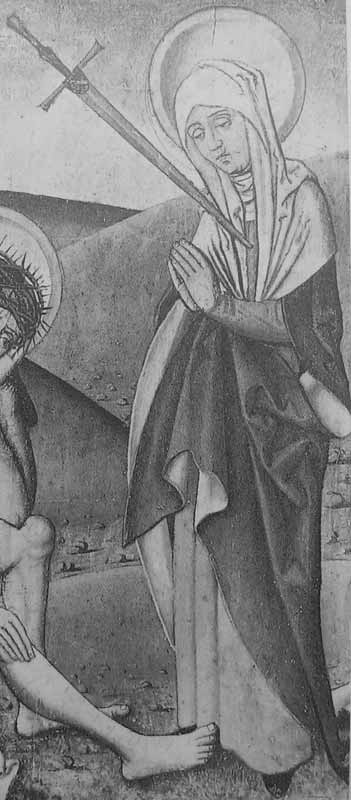| Author |
Message |
|
Lukasz Derewiecki
|
 Posted: Tue 04 Dec, 2007 4:47 am Post subject: Swords in Gothic and Renaissance Art Posted: Tue 04 Dec, 2007 4:47 am Post subject: Swords in Gothic and Renaissance Art |
 |
|
Hello
Below, you can see a few examples of swords which I found in Polish late Gothic and early Renaissance art.
I also tried to categorize them according to the Oakeshott's typology and I would like to make sure if I did it correct.
What do you think about these swords?
I invite you to the discussion.
1. Two woodcuts made in Cracow in first half of 16th century shows a swords of Type XX.
 Attachment: 46.02 KB Attachment: 46.02 KB

 Attachment: 49.8 KB Attachment: 49.8 KB

Last edited by Lukasz Derewiecki on Tue 04 Dec, 2007 12:19 pm; edited 2 times in total
|
|
   |
 |
|
Lukasz Derewiecki
|
 Posted: Tue 04 Dec, 2007 4:54 am Post subject: Posted: Tue 04 Dec, 2007 4:54 am Post subject: |
 |
|
2. Painting from the first half of 16th century shows a swords of Type XVIII
 Attachment: 31.76 KB Attachment: 31.76 KB

|
|
   |
 |
|
Thomas Parsons
|
 Posted: Thu 10 Jan, 2008 12:07 pm Post subject: Posted: Thu 10 Jan, 2008 12:07 pm Post subject: |
 |
|
Greetings! And thank you for bringing to my attention these interesting works.
Now down to the nit and grit:
Oakeshott's typology takes three elements of the sword into account:
- pommel (alphabetical cataloging)
- crossguard (arab numerals)
- blade (roman numerals; this is the element that made his typology so revolutional and often leads us to ommit the other two ).
So when describing any weapon to the full with his typology we must name all three elements, Oakeshott does so in this order: blade / pommel / crossguard and so shall I.
 Here I'll add that I agree with you about the blade format of the first image Here I'll add that I agree with you about the blade format of the first image 
Thus the full description of the sword featured in the first illustration (involving St Peter) would read: XX, T4, 5
 Next comes the slavic dignitary (I really cannot place him geographically other than from somewhere between Scandinavia and Hungary... I would appreciate input as to the original location this piece was produced in). Here I am slighlty at a loss as to the blade, it is not completely clear wether it depicts: Next comes the slavic dignitary (I really cannot place him geographically other than from somewhere between Scandinavia and Hungary... I would appreciate input as to the original location this piece was produced in). Here I am slighlty at a loss as to the blade, it is not completely clear wether it depicts:
- two fullers running the length of the blade; which doesn't fit the type XX blade description (closer to viking descriptions really  ...) ...)
- one single wider fuller also running the length of the blade; this would place it as either a type X or Xa both of which seem extraordinarily odd seeing as these blades date back to the Xth century if not slightly earlier...
The cross however presents us with only one clear possibility: a style 12 typically "S" curved crossguard
The pommel is I believe of the same type as the previously discussed sword: T4
This gives us a (nearly  )full description reading: ?, T4, 12 )full description reading: ?, T4, 12
 Finally the heart pierced saint: Finally the heart pierced saint:
I cannot agree to the sole XVIII type blade whose key characteristics is to have a broad blade at the hilt with edges tapering in a curve to form a sharp point.
- Firstly the blade certainly tapers to a point but not in a curved manner.
- Secondly taking the overall proportions of the weapon into account I would say that the blade is positively slender. This is better understood if you take into account the fact that it seems that a small portion of the blade is already embedded in the saints chest, yet even assuming the blade is on the verge of penetration the weapon has very "slim" lines...
All that to support my idea that it is in fact a type XVIIIb blade in this instance.
The cross could be one of two styles, the obvious leather chappe here masks the location where the differentiating detail would be. The two possibilities being:
- style 5
- style 10
The pommel is slighlty unclear so all I can say in this instance is that would seem to be of the "T" family, which one I cannot say...
so once again nearly complete descritpion: XVIIIb, T(  ), 5 or 10 ), 5 or 10
Hope this helps!
Last edited by Thomas Parsons on Fri 11 Jan, 2008 12:10 pm; edited 1 time in total
|
|
  |
 |
|
Thomas Parsons
|
 Posted: Thu 10 Jan, 2008 12:10 pm Post subject: Posted: Thu 10 Jan, 2008 12:10 pm Post subject: |
 |
|
One question: I don't suppose you have a slighlty more specific date than "early XVIth" for the lady saint? only the work looks as though it could alo be late XVth which would also fit the sword depicted... Possibly the artists' name?
Thanks!
|
|
  |
 |
|
|

